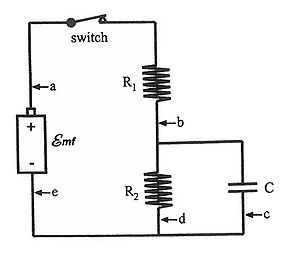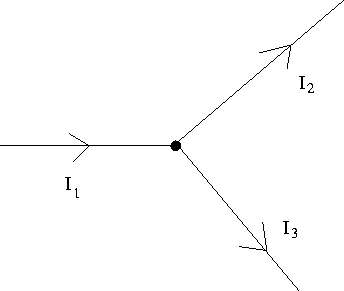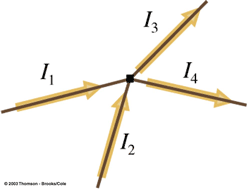Node Rule
Claimed by Ingrid Cai
Kirchoff's node rule,also known as Kirchoff's junction rule, further exercises the law of conservation of energy and states that if current is constant, all the current that flows through one junction must be equal to all the current that flows out of the junction.
Definition
The node rule is one of Kirchhoff's laws regarding circuits and current. This law states that at any junction in an electrical circuit, the amount of current flowing into the junction is equal to the amount of current flowing out of the junction. This law is also referred to as Kirchhoff's junction rule, Kirchhoff's nodal rule, Kirchhoff's current law, and Kirchhoff's first law. This rule is an application of the conservation of electric charge, basically that charge within a circuit cannot be created or destroyed.
Mathematically, the Node Rule states ∑ I = 0, where I stands for the current of the individual parts or wires in a circuit.
Kirchhoff's Laws
Kirchhoff developed two very important rules that allow us to "solve" simple circuits, or find out different values for the different components involved in the circuit. The node rule is Kirchhoff's first rule, but there is one more, called the loop rule or Kirchhoff's Voltage Law. The loop rule states that, going around in a loop within a circuit, one will find that the voltages around the loop will sum to 0. Because voltage is just energy per unit charge, and both energy and charge are conserved, this is basically stating that no charge or energy is lost or created within the circuit. Both of Kirchhoff's Laws are very important to solving circuits and you can click here to learn more about the loop rule.
Examples
Ex. 1
Below is a node in a circuit. I1 is equal to 10 amps. I2 is equal to 4 amps. What is I3?
You can solve for I3 using the node rule. The current flowing into the node is I1, or 10 amps, and the current flowing out of the node is 12 + I3. We know that the current flowing in must equal the current flowing out, so 10 amps = 4 amps + I3. Therefore I3 must equal 6 amps.
Ex. 2
In the picture below, I1 equal 23 amps, I2 equals 5 amps and I3 equals 42 amps. What is I4?
The current flowing into the node is I1 + I2, or 23 amps plus 5 amps, or 28 amps. The current flowing out of the node is I3 + I4, or 42 amps plus I4. Applying the node rule, 28 amps = 42 amps + I4. So I4 equals -14 amps. But how could we get a negative current? The answer is there is not an actual negative current in the wire, that would be physically (get it, haha) impossible. However, we guessed the direction of I4 wrong. The current is not flowing out of the node, but actually into the node.
Limitations
Time-Varying Currents
Kirchhoff's law is based off the conservation of charge along with the nature of conductors. This law assumes that current will immediately flow from one end of the conductor to the other, which may not be true for time-varying currents, especially with higher frequencies.
Regions vs Circuits
Throughout a region, the charge can vary and be non-uniform, unlike in a wire. According to the law of conservation of charge, the only way to have a non-uniform charge density is if there is a net flow of current in or out of the region, which clearly violates the Node Rule. Therefore the node rule cannot be applied to regions with non-uniform charge densities. When looking at a junction in an electric circuit, we are looking at a point and therefore the point (which is infinitesimally small) must have a uniform charge distribution. In general, wires should have a uniform charge distribution across their length, because they are conductors and allow for the movement of charge.
Other Topics
Solving Circuits

In order to solve circuits, we must first define a couple characteristics of circuits.
- The voltage of a (perfect, or non-resistive) wire is equal to its length (in meters) times its electric field.
- The voltage of an ohmic resistor (including a resistive wire) is equal to current times resistance.
- The voltage of a capacitor is equal to the charge on the capacitor divided by its capacitance.
There are other characteristics and equations that may be useful, but these two are the most important and used. If you are confused by any of the components of circuits mentioned above, visit the "Components" page. Below is a circuit. Using the node and loop rules we will find the current at points a, b, c, d, and e, and the charge on the capacitor after the switch has been closed for a very long time.
First you must realize that when the capacitor is fully charged, no current will flow through the capacitor, which is an important characteristic of a capacitor. From this we can say that the current through point c is 0.
Using the node rule, we can see that the current through resistor 1 and resistor 2 must be the same because, since no current flows through the wire connected the capacitor, all of the current must flow through one loop containing both resistors. So the current at a, b, d and e must all be the same. Due to the loop rule, the emf of the battery must be equal to I*R1 + I*R2. Therefore, I = emf/(R1 + r2); this is the current through points a, b, d and e. Using the loop rule, we can look at the loop containing the capacitor and resistor 2. We know the voltage in resistor 2 is equal to I*R2. We know the voltage of the capacitor is equal to its charge divided by C (its capacitance). Because of the loop rule, we know that these two voltages must be equal, so I*R2 = Q/C. Therefore, Q = I*R2*C. Replacing I with the current we found above, Q = (emf/(R1 + R2))*R2*C. As you can see, in order to solve this circuit, we had to use the node rule. In fact, we used the node rule at the very beginning of solving this circuit and there was no way possible we could have solved this problem without the node rule.
History
Gustav Kirchhoff was a German physicist who lived during the 19th century. There are many equations and laws named after him that he helped to discover, one of them being the node rule. His circuit laws (the node rule and loop rule) were the first laws that he conceived, and he actually did this during his years in school and later wrote his doctoral dissertation on them. He created these laws in a time where electricity was a fairly new and was not commonly used.
Connectedness
The Node Rule is connected to a lot of other topics in physics. The loop rule is the most important one, as the node rule and loop rule in conjunction allow us to solve circuits. The node rule is also connected to other concepts such as voltage, current and electricity. See the "Further Reading" section to read more on these topics.
See Also
External Links
https://en.wikipedia.org/wiki/Kirchhoff%27s_circuit_laws#Kirchhoff.27s
http://www.tutorvista.com/content/physics/physics-iv/current-electricity/kirchhoffs-rules.php
References
Matter & Interactions 4th Edition by Ruth W. Chabay & Bruce A. Sherwood

